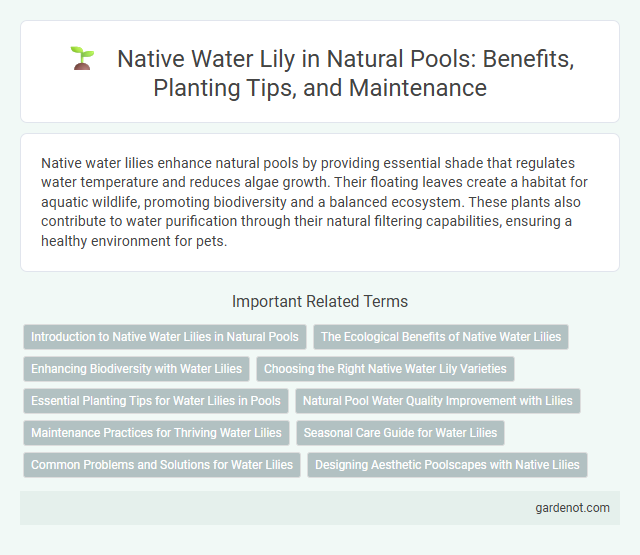Native water lilies enhance natural pools by providing essential shade that regulates water temperature and reduces algae growth. Their floating leaves create a habitat for aquatic wildlife, promoting biodiversity and a balanced ecosystem. These plants also contribute to water purification through their natural filtering capabilities, ensuring a healthy environment for pets.
Introduction to Native Water Lilies in Natural Pools
Native water lilies enhance natural pools by providing essential ecological benefits such as oxygenation and habitat for aquatic life. Their broad, floating leaves reduce algae growth by shading the water surface, promoting a balanced ecosystem. These lilies also contribute to water clarity and aesthetic appeal, making them integral to sustainable natural pool design.
The Ecological Benefits of Native Water Lilies
Native water lilies provide essential habitat for aquatic wildlife, supporting biodiversity by offering shelter and breeding grounds for fish and insects. Their extensive root systems improve water quality by stabilizing sediment and absorbing excess nutrients, which helps reduce algal blooms. These plants contribute to oxygenation of the water, enhancing the overall health of natural pool ecosystems.
Enhancing Biodiversity with Water Lilies
Native water lilies significantly enhance biodiversity in natural pools by providing critical habitat and food for a variety of aquatic species, including insects, amphibians, and small fish. Their broad leaves offer shade that helps regulate water temperature, promoting a balanced ecosystem. By supporting diverse wildlife and improving water quality through natural filtration, water lilies contribute to a healthy and sustainable aquatic environment.
Choosing the Right Native Water Lily Varieties
Selecting the right native water lily varieties depends on factors such as climate suitability, flower color preference, and growth habits to ensure optimal bloom and ecosystem balance in natural pools. Hardy species like Nymphaea odorata thrive in temperate zones, while tropical varieties require warmer water temperatures. Prioritizing natives supports local biodiversity, reduces maintenance, and enhances water quality through natural filtration processes.
Essential Planting Tips for Water Lilies in Pools
Plant native water lilies in natural pools by selecting a sunny location with at least 6 hours of direct sunlight daily to promote vibrant blooms. Use containers filled with heavy clay soil planted at a depth of 12 to 18 inches below the water surface to anchor roots and facilitate healthy growth. Regularly divide overcrowded rhizomes every 2 to 3 years to maintain plant vigor and prevent water stagnation.
Natural Pool Water Quality Improvement with Lilies
Native water lilies enhance natural pool water quality by absorbing excess nutrients, reducing algae growth, and providing essential shade that inhibits sunlight penetration. Their extensive root systems promote biological filtration, increasing oxygen levels and supporting beneficial microbial activity. Incorporating native lilies balances the aquatic ecosystem, leading to clearer, healthier water without chemical treatments.
Maintenance Practices for Thriving Water Lilies
Native water lilies thrive in natural pools with balanced conditions, requiring regular monitoring of water quality parameters such as pH, temperature, and nutrient levels. Gentle pruning of yellowing leaves and removal of debris prevent decay and maintain clear water, promoting healthy growth. Maintaining adequate sunlight exposure and ensuring proper water depth between 18 to 36 inches optimize photosynthesis, supporting robust lily development.
Seasonal Care Guide for Water Lilies
Native water lilies thrive with seasonal care that includes ensuring full sun exposure and maintaining water temperatures between 70-85degF during the growing season. In spring, divide and replant tubers in nutrient-rich aquatic soil to promote healthy growth, while removing dead leaves in fall prevents decay and maintains water quality. Winter protection involves lowering pots deeper into the pool to avoid freezing, ensuring the native water lilies survive and bloom beautifully year after year.
Common Problems and Solutions for Water Lilies
Common problems for native water lilies include yellowing leaves, often caused by nutrient deficiencies or poor water quality, and fungal infections leading to leaf spots. Ensuring balanced water conditions with proper aeration and regular removal of decaying plant material helps prevent these issues. Introducing beneficial aquatic bacteria and using organic treatments can effectively control pests and diseases without harming the natural pool ecosystem.
Designing Aesthetic Poolscapes with Native Lilies
Native water lilies enhance natural pools by offering vibrant blooms that attract pollinators and support local ecosystems. Their broad floating leaves provide natural shade, reducing algae growth while maintaining clear, balanced water. Incorporating native lilies into poolscapes creates visually stunning, ecologically sustainable aquatic environments that blend seamlessly with surrounding landscapes.
Native water lily Infographic

 gardenot.com
gardenot.com